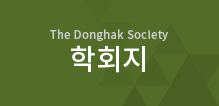pISSN: 1598-7566 / eISSN: 2713-3605
동학학보, Vol.74 (2025)
pp.85~132
DOI : 10.46639/kjds.2025.74.3
동학과 유학의 심학 차이 고찰
본 연구에서는 동학의 심학(心學)과 유학의 심학 차이를 고찰하고자 한다. 수운의 글에는 당시 지배적인 지적 전통이었던 유학의 용어를 연상 시키는 표현들이 자주 등장한다. 아마도 이러한 이유로, 유학에 조예가 있는 학자들은 동학이 만고에 없던 무극대도(無極大道)라는 독자적 사 상임에도 불구하고 이를 유학의 한 갈래로 오해하기도 한다. 그러나 동 학의 심학(心學)과 유학의 심학 사이에는 중요한 차이점들이 존재한다. 먼저 동학의 심학(心學)은 ‘오심즉여심(吾心卽汝心)’이라는 심법(心法) 에서 출발한다. 오심은 천심(天心)이고, 여심은 인심(人心)이다. 오심인 천심(天心)은 상제(上帝)의 마음이자 성령 활동의 주체라는 관점을 고찰 한다. 특히, “영성의 활동이 시작되었고[포태], 영의 결정으로써 만물 의 조직을 낳았고[탄생], 만물의 조직으로써 다시 영의 표현이 생긴 것 이라[생활]”는 의암의 교설을 통해 동학의 심학 범주는 포태·탄생·생 활을 모두 포함하는 심학 범주임을 살펴보았다. 다음으로, 유학의 심학(心學)은 요임금이 전한 ‘윤집궐중(允執厥中)’이라는 구절에 그 기원을 두며, 이는 후에 순임금에 의해 ‘인심유위(人心 惟危), 도심유미(道心惟微), 유정유일(惟精惟一), 윤집궐중(允執厥中)’이 라는 16자 심법으로 확장되었는데, 이는 기존 구절에 3단어를 추가한 것이다. ‘유정(惟精)’은 인심(人心)과 도심(道心)을 분별하여 서로 혼동되 지 않도록 하는 것을 의미하며, ‘유일(惟一)’은 중용(中庸)의 도를 한결 같이 유지하는 것을 뜻한다는 관점을 고찰한다. 일상생활 속에서 중용 의 도를 온전히 실천하기 위해서는 유정과 유일의 수행이 필수적이라 는 점도 함께 살펴본다. 마지막으로 수운의 글 중에 유학 사상과의 비교가 명시적으로 드러 나는 일부 구절들을 간략히 분석함으로써, 동학과 유학의 심학(心學) 사상 간의 차이를 살펴보았다. 결론적으로 본 연구는 동학의 심학(心學)이 인간의 마음(人心)을 넘 어 생명의 근원인 천심(天心)을 포괄하며, 포태·탄생·생활의 전 과정 을 아우르는 생명 중심의 철학으로 이해될 수 있음을 살펴보았다. 유 학의 심학은 인간의 삶과 사회적 행위 전반에 걸쳐 중용(中庸)의 실천 을 강조하는 관계 중심의 도덕 철학으로 나타난다. 이러한 비교 고찰 을 통해 동학과 유학의 심학은 본질적으로 뚜렷한 차이를 지닌다는 점을 고찰해 보았다.
A Comparative Study on the Differences Between the Mind Philosophies(Simhak) of Donghak and Confucianism
This study seeks to investigate the differences between the mind philosophy (simhak) of Donghak and that of Confucianism. Suun’s writings frequently include phrases that resemble the terminology of Confucianism, which was the dominant intellectual tradition at the time. Perhaps as a result, some scholars well-versed in Confucian thought have occasionally misinterpreted Donghak—despite its identity as the unparalleled Mugeuk Daedo (Great Way of the Infinite)—as a derivative branch within the Confucian tradition. However, significant differences exist between the mind philosophy (simhak) of Donghak and that of Confucianism. To begin with, Donghak’s philosophy of mind (simhak) begins with the mental principle (simbeop) of ‘O-sim is Yeo-sim’ (吾心卽 汝心), wherein O-sim is identified with Cheon-sim (the Heavenly Mind), and Yeo-sim is identified with In-sim (the human mind). This study examines the view that O-sim, identified as Cheonsim (the Heavenly Mind), is the mind of Sangje (the Lord on High) and serves as the active agent of the Holy Spirit’s work. In particular, through the teachings of Uiam, this study examines the claim that Donghak’s mind philosophy (simhak) encompasses the full cycle of spiritual activity—conception (胞胎), birth (誕 生), and life (生活)—as reflected in the statement: ‘The activity of spirituality began; [conception] the determination of spirit gave rise to the organization of all things; [birth] and through the organization of all things, the manifestation of spirit reappeared. [life] Next, the mind philosophy (simhak) of Confucianism is traced to the transmission of the phrase Yunjipgweoljung (允執厥中) by Emperor Yao, which was later expanded by Emperor Shun into the sixteen-character mind principle: ‘Insim yu wi, dosim yu mi, yujeong yuil, yunjipgweoljung’ (人心惟危 道心惟微 惟精 惟一 允執厥中), adding three key concepts to the original. This study examines the view that Yujeong (惟精) refers to discerning between the human mind (insim) and the moral mind (dosim) so that they do not become confused, while Yuil (惟一) signifies maintaining constancy in the Way of the Mean (jungyong). It is through the practice of yujeong and yuil that one is able to properly enact the Way of the Mean in everyday life. Finally, this study briefly investigates the differences between the mind philosophies (simhak) of Donghak and Confucianism by examining selected passages from Suun’s writings that explicitly engage in comparison with Confucian ideas. In conclusion, this study argues that the mind philosophy (simhak) of Donghak can be understood as a life-centered moral philosophy, one that transcends the human mind (insim) and embraces the Heavenly Mind (cheon-sim)—the source of life—encompassing the full cycle of conception, birth, and lived experience. The simhak of Confucianism is shown to be a relational moral philosophy that emphasizes maintaining the Mean (jungyong) throughout human life and social conduct. Through this comparative examination, the study highlights the significant differences between the mind philosophies of Donghak and Confucianism.








